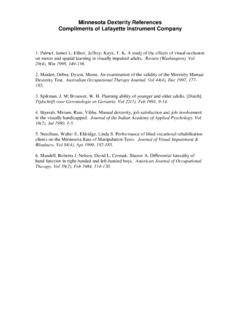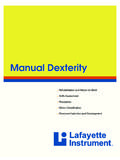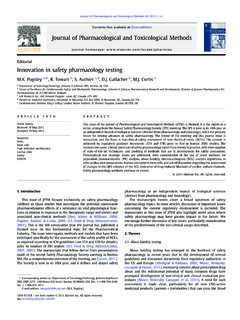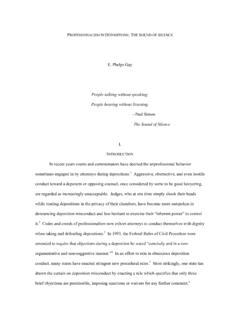Transcription of The Sound of Silence: Ionic Mechanisms Encoding …
1 NeuronArticleThe Sound of Silence: Ionic MechanismsEncoding Sound TerminationCornelia Kopp-Scheinpflug,1 Adam Tozer,1 Susan W. Robinson,1 Bruce L. Tempel,2 Matthias H. Hennig,3,4and Ian D. Forsythe1,*1 MRC Toxicology Unit, Hodgkin Building, University of Leicester, Leicester LE1 9HN, UK2VM Bloedel Hearing Res. Ctr. and Department of Otolaryngology, University of Washington, Seattle, WA 98195, USA3 Institute for Adaptive and Neural Computation, School of Informatics, University of Edinburgh, EH8 9AB Edinburgh, UK4 Centre for Systems Biology at Edinburgh, CH Waddington Building, The Kings Buildings Campus, EH9 3JD Edinburgh, responses upon termination of a stimulus arecrucial for perceptual grouping and gap gaps are key features of vocal communication,but an Ionic mechanism capable of generating fastoffsets from auditory stimuli has proven firing arises in the brainstem superior paraoli-vary nucleus (SPN)
2 , which receives powerful inhibi-tion during Sound and converts this into preciseaction potential (AP) firing upon Sound patch recording in vitro showed thatoffset firing was triggered by IPSPs rather thanEPSPs. We show that AP firing can emerge from inhi-bition through integration of large IPSPs, driven by anextremely negative chloride reversal potential (ECl),combined with a large hyperpolarization-activatednonspecific cationic current (IH), with a secondarycontribution from a T-type calcium conductance(ITCa). On activation by the IPSP, IHpotently acceler-ates the membrane time constant, so when thesound ceases, a rapid repolarization triggers multipleoffset APs that match onset timing duration and termination of a sensory input are universalparameters underlying sensory processing that require someelement of neural computation.
3 This is especially true in theauditory system, where preservation of timing information isimportant for Sound localization, auditory scene analysis, andcommunication (Snell and Frisina, 2000). The mammalian audi-tory brainstem possesses circuits involved in gap detectionand Sound duration Encoding (Kadner and Berrebi, 2008; Kadneret al., 2006) in which the superior paraolivary nucleus (SPN) andthe medial nucleus of the trapezoid body (MNTB;Banks andSmith, 1992; Kuwabara and Zook, 1991) are key components(Figure 1A).The rodent SPN (referred to as SPON in rats:Saldan a and Ber-rebi, 2000) is considered to be the homolog of the dorsomedialparaolivary nucleus in other mammals (Grothe and Park, 2000).
4 The ubiquitous presence of this nucleus across many mam-malian species, independent of their specialization for low- orhigh-frequency Sound localization, also suggests that the SPNis involved in functions other than Sound localization (Behrendet al., 2002; Dehmel et al., 2002; Kulesza, 2008; Kulesza et al.,2003; Schofield, 1995; Zook and Casseday, 1982). The SPNreceives a weak bilateral (predominantly contralateral) excitatoryinput from the cochlear nuclei (Kuwabara et al., 1991) anda strong, tonotopically ordered inhibitory input from the MNTB(Banks and Smith, 1992; Sommer et al., 1993). During a Sound ,action potential (AP) firing is suppressed by MNTB inhibition,but when the Sound ceases, the SPN is released from this inhi-bition and generates rebound APs as an offset response (Behrend et al.)
5 , 2002; Dehmel et al., 2002; Kulesza et al.,2003). This IPSP-induced offset firing is mediated by glycinereceptors (Kadner and Berrebi, 2008) and three mechanismshave been postulated to explain the offset firing:(1) Coincident excitation and inhibition suppress firing duringthe Sound , but the excitation outlasts the inhibition (dis-cussed inKulesza et al., 2003).(2) An initial evoked IPSP becomes depolarizing as a conse-quence of an activity-dependent shift in ECl(Kaila et al.,1997).(3) The offset response is generated by the intrinsic conduc-tances of the SPN neuron. It seems unlikely that releasefrom MNTB inhibition could be the sole mechanismgenerating offset firing, since other major targets ofMNTB inhibition (such as the medial and lateral superiorolives) rarely exhibit offset firing (Barnes-Davies et al.
6 ,2004; Scott et al., 2005).We demonstrate that offset firing is an intrinsic activity of SPNneurons with the Ionic mechanism requiring three crucialelements: Sound -evoked IPSPs, a large electrochemical chloridegradient, and the combination of a hyperpolarization-activatedcation current, IH, with a T-type calcium current, ITCa. Modelinghas suggested that IHcould contribute to stimulus durationencoding (Hooper et al., 2002); our results provide experimentalevidence for this but also demonstrate the crucial importanceof the IPSP and enhanced chloride gradients, so that the inhibi-tion can provide sufficient hyperpolarization to activate IHin re-sponse to physiological sensory input. We have confirmed thisinterpretation using Sound -evoked SPN single-unit recordingsNeuron71, 911 925, September 8, 2011 2011 Elsevier vivo, characterized the conductances using voltage clampin vitro, and demonstrated that these conductances aresufficient to explain the results by computational result is a physiologically elegant solution to computationof Sound termination .
7 A cell-specific conversion of inhibitioninto excitatory AP firing, which enhances timing accuracy andprovides crucial information for downstream duration Neurons Show Burst Offset Firing In Vitroand In VivoThe majority of SPN neurons showed AP firing as an offsetresponse following Sound stimulation in vivo (64%, extracel-lular single unit, n = 15,Figures 1E, 1F, and 1I) or followingFigure 1. The MNTB Provides Sufficient Inhibition to Cause Offset Responses in the Mouse SPN In Vivo and In Vitro(A) Diagram of the brainstem at the level of the superior olivary complex showing the stimulation and recording sites.(B) Retrograde labeling of SPN cells after fluorogold injection into the ipsilateral IC.
8 (C) SPN in vitro: whole-cell patch recording under current clamp (upper trace) showing the typical hyperpolarization and sag during a 200 ms hyperpolarizingcurrent step ( 400 pA, lower trace). After the end of the current step the potential rapidly returns to rest with a burst of APs. Inset: ten superimposed traces athigher gain shows that the rhythmic offset burst usually contains two to four well-timed APs.(D) MNTB in vivo: dot raster plot to a repetitive (10 runs/100 ms stimulus) Sound stimulation at CF ( kHz) with intensity increasing from 0 to 80 dB SPL. Firingincreases with intensity and spontaneous firing is suppressed afterwards.(E) SPN in vivo: dot raster plot for a repetitive (10 runs/100 ms stimulus) Sound stimulation at CF ( kHz) with intensity increasing from 0 to 80 dB activity is suppressed during Sound stimulation while offset firing increases with Sound intensity.
9 (F) SPN single-unit recording in vivo during 100 ms tone stimulation (lower trace) at CF/80 dB SPL. The dot-raster plot shows a well-timed offset response. Inset:the PSTH has distinct multiple peaks, indicating rhythmicity of the offset response.(G) SPN in vitro: IPSCs evoked by electrical stimulation of the MNTB are blocked by strychnine (1mM).(H) SPN in vitro: synaptic stimulation (of MNTB) at 100 Hz/100 ms produced a reliable offset response with or without contributions from excitatory synapses(upper and middle trace, respectively). Additional application of strychnine (lower trace) caused the IPSP hyperpolarization to decline and the offset response waseliminated.(I) The proportion of SPN cells with and without offset firing in vivo and in vitro.
10 The dotted line in the in vitro offset-bar (far right) represents the subpopulation ofcells with only one AP in the offset Sound of Silence912 Neuron71, 911 925, September 8, 2011 2011 Elsevier in vitro (89%, whole-cell patch clamp, n = 70,Figures 1C, 1H, and 1I). A minority of neurons showed no offsetfiring upon hyperpolarization (Figure 1I), but instead showed sus-tained or onset firing in vivo, as seen in other species (Behrendet al., 2002; Dehmel et al., 2002). The offset firing characteristi-cally exhibited an intrinsic rhythm observed as multiple distinctpeaks in the poststimulus time histogram (PSTH;Figure 1F,inset). The average number of APs in the offset response (n = 65) with an interspike interval of ms ms (n = 26 cells) between the first two APs and increasingvariability for the subsequent APs, as shown in the inset inFig-ure 1 C.















